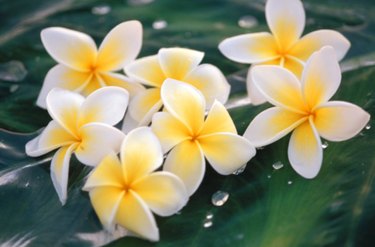
Plumeria is a tropical plant that grows outside year-round in USDA hardiness zones 9 and higher; in zones 8 and lower, the container plants will have to be brought inside for the winter. Soil quality and composition are both very important to the growth of large, beautiful and fragrant blossoms, so make it the best soil you can. Consider covering the top of the soil with 1 to 2 inches of compost. That way, the soil will take on additional nutrients every time you water.
Drainage
Video of the Day
Drainage is very important for successful container growth of plumeria as the plants do not respond well to what gardeners call "wet feet." EasytoGrowBulbs.com, an online gardening resource, recommends using a good quality cactus potting mix -- these potting soils are very well draining because cacti, too, dislike wet feet. The soil should also be fertile -- plumeria benefits from incorporation of sheep or cow manure. Manure retains moisture but also makes the soil more porous, allowing water to pass through it while providing supplemental nutrients.
Video of the Day
Make Your Own Potting Soil
If you're just starting out growing plumeria, it's easy to make your own potting mix that will ensure an adequate nutrient supply and sufficient drainage. Replace about one-third of the potting soil necessary to fill your pot with coarse sand, such as builder's sand. The sand you find on the playground or in sandboxes will become compacted when you water it.
Soil Level
When potting your plumeria, make sure that the root ball sits at exactly the same level as the soil in the pot. In other words, the root ball shouldn't sit any deeper in its new container than it did in the pot from the nursery.
Types of Pots
Gardeners are often drawn to clay or glazed terracotta pots because they are typically very beautiful and retain a classic gardening style, but clay and terracotta are extremely porous and draw moisture out of the soil. While it may suit your basic spider plant or other houseplant that doesn't mind soil on the dry side, plumeria is more finicky and a plastic pot will serve its needs far better. Select a pot with at least four drainage holes. If there aren't enough, drill a few yourself. Because most people grow plumeria to enjoy its fantastically fragrant blossoms, it's imperative that the roots have access to sufficient moisture during the growing season and a plastic pot meets those needs.